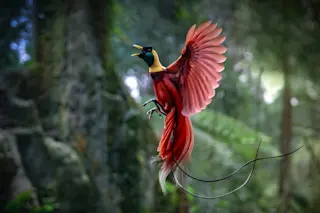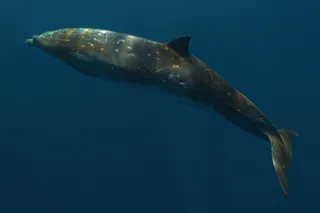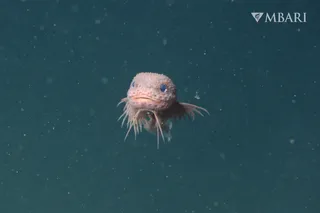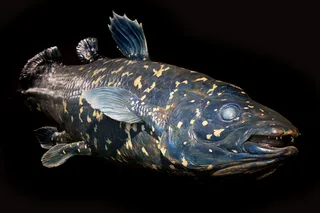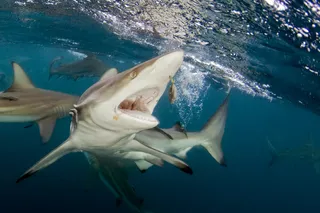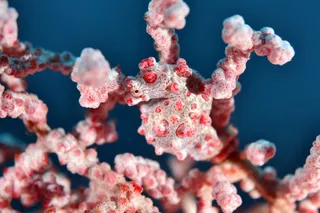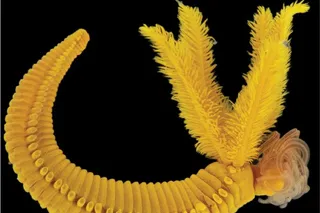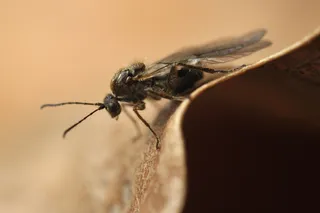Birds-of-paradise are among the most resplendent creatures on Earth, with long, elaborate feathers in eye-popping shades of yellow, blue, and red. Naturalists have admired them for centuries. Yet it turns out they didn’t know the half of it.
As if those vibrant colors weren’t enough, a recent study found that the birds — native to Australia, Indonesia, and New Guinea — are also biofluorescent. Their skin and plumage absorb light at high-energy wavelengths, then re-emit it at low-energy wavelengths visible to other birds as a bright yellow-green. Basically, they harness the sun’s rays to make their already impressive displays even more dazzling.
Biofluorescence by itself isn’t big news; it shows up in plenty of animals, including humans (our teeth fluoresce under UV light). But almost always it either has no discernible function, or it’s used for camouflage.
This, says lead author Rene Martin, a biologist at the University of Nebraska-Lincoln, “is one of the few cases where we’re seeing biofluorescence is very likely being used as a signal. That’s where it tends to be rare.”
Evolution for Desire
The birds-of-paradise evolved optimal brilliance to communicate something, and that something is their own attractiveness: Like so many of their striking features, biofluorescence seems to help them entice mates.
“The females are very choosy,” Martin says, “and the males tend to be very flashy. Biofluorescence is just a small component of that.”
Martin and her colleagues tested all 45 species, using specimens from the American Museum of Natural History, and found biofluorescence in each of the 37 core birds-of-paradise. This suggests that their common ancestor was also biofluorescent, and for some reason the other eight species lost that trait over time.
In those that retained biofluorescence, the trait has diversified wildly under the auspices of sexual selection. This is the lesser-known force that, along with natural selection, drives evolution. Whereas natural selection favors the fit, sexual selection favors the beautiful: The most desirable individuals are most likely to pass on their genes.
Female choosiness can result in a positive feedback loop where exaggerated features grow more ornate from generation to generation, even to the point of conflicting with natural selection — a male bird-of-paradise is conspicuous not only to mates, but also to predators.
Nevertheless, sexual preference is a powerful sculptor. And birds have terrific eyesight, with visual acuity and color discrimination to rival any animal, so it’s no surprise these creatures evolved such a dramatic appearance.
Read More: Glow-in-the-Dark Amphibians Are Way More Common Than Scientists Thought
The “Black Hole” Effect
Beyond biofluorescence, birds-of-paradise have another trick to enhance their look, and to stand out amid a noisy forest background. A 2018 study found that the birds’ colors aren’t just brighter, the surrounding areas are also darker — they’ve evolved “super black” feathers, which absorb more light than the feathers of other birds. This “black hole” effect creates an intense, irresistible contrast.
Some species fan these plumes around their face to create a dark halo, then open their biofluorescent mouth for potential mates to appraise. In other species the females observe from above, so males spread their feathers out skirt-like to isolate a spark of biofluorescence on the crown of their head.
They even choose their display sites carefully to exploit whatever sunlight is available to them. As Martin put it, “they're playing with that light source to enhance their flashiness.”
Searching for a Purpose
Given that biofluorescence is often a mere byproduct of the structure of animal tissues, you can’t just assume it serves some tangible purpose. To be sure that it does in birds-of-paradise, Martin’s team followed an established framework with five criteria.
They proved four of them. The pigments are well-suited to absorb light in the birds’ natural habitat, they’re viewed against a contrasting background, they’re located in the relevant bodily regions, and the birds’ eyes are particularly sensitive to the re-emitted wavelengths.
But there’s one thing the researchers haven’t yet been able to test: Whether biofluorescence changes the behavior of females who behold it. That’s a tough one; the team would need to compare mating success in males with and without biofluorescence, so for the control group they’d need a way to turn off the UV light that excites that biofluorescence.
We can’t turn off the sun, of course, but it might be possible to run such an experiment with captive birds under artificial light. And the right doors seem to be opening already — shortly after her paper was published, Martin received an email from a zookeeper who offered to collaborate.
The woman didn’t seem surprised to learn that birds-of-paradise were biofluorescent. “Every time I see their feathers,” Martin recalls her saying, “I feel like there must be more.”
Article Sources
Our writers at Discovermagazine.com use peer-reviewed studies and high-quality sources for our articles, and our editors review for scientific accuracy and editorial standards. Review the sources used below for this article:
Royal Society Open Science. Does biofluorescence enhance visual signals in birds-of-paradise?
PLOS One. Avian Cone Photoreceptors Tile the Retina as Five Independent, Self-Organizing Mosaics
Nature. Structural absorption by barbule microstructures of super black bird of paradise feathers
The Royal Society. Fluorescence as a means of colour signal enhancement



